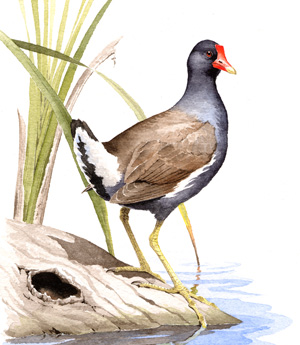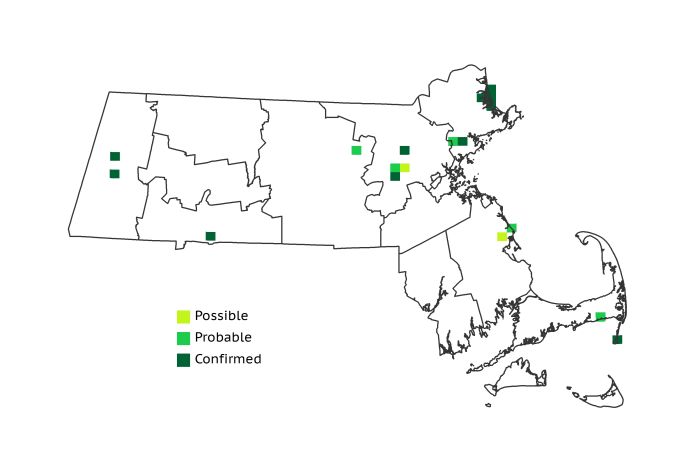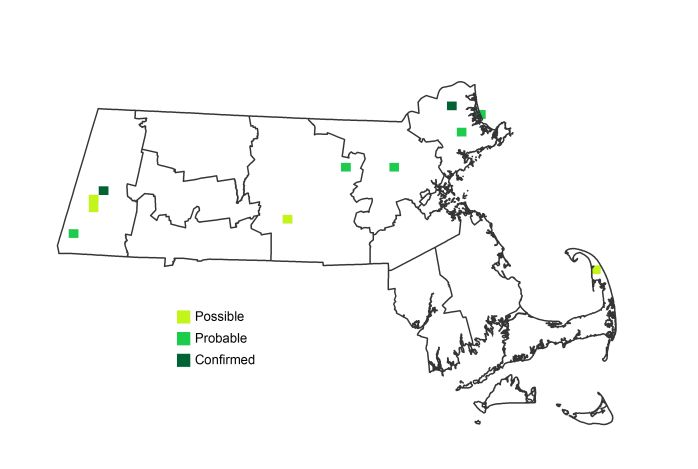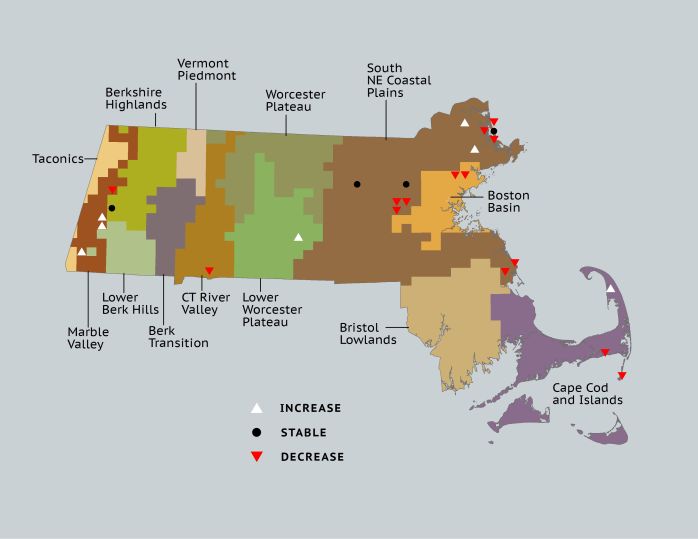Breeding Bird Atlases (BBA)
Find a Bird
Common Gallinule
Gallinula chloropus

Very local and strongly declining
Conservation action urgent
Species of Special Concern
“The long-legged moor-hens dive, / And hens to moor-cocks call; / Minute by minute they live: / The stone's in the midst of all.” William Butler Yeats, “Easter, 1916”
Common Gallinules occupy a niche between those of the reclusive, vegetation-dwelling rails and the gregarious, aquatic American Coot. Despite their oft-revisited appellation Moorhen, one is not very likely to encounter one of these rallids in the open acidic environment of a moor. Instead, gallinules are attracted to many of the same marshes that the rails use, but they tend to feed out in the open more frequently than rails do, often taking to the water to forage or escape predators. This behavior makes Common Gallinules easier to observe, and it also allows us to speak with greater certainty on the scarcity of this Species of Special Concern in Massachusetts.
Historic Status
“Mr. Cabot states that a Florida Gallinule, G. galeata [chloropus] was shot in Fresh Pond several years ago,” noted William Peabody in 1839. By 1878, reports of the gallinule’s occurrence in Massachusetts could no longer be deemed as potentially spurious, as was this second-hand account, because Joel Asaph Allen listed them as “doubtless occasionally breeding” in the state. By the beginning of the twentieth century, Reginald Heber Howe and Glover Morrill Allen called the species an “uncommon and local summer resident,” and noted breeding on Cape Cod (Howe & Allen 1901). As the last century dawned, the bird formerly known as the Common Moorhen and now Common Gallinule began a gradual northward expansion throughout much of the eastern half of the country.
Atlas 1 Distribution
Common Gallinules were never numerous or conspicuous as breeders in Massachusetts, and their limited Atlas 1 distribution emphasized the species’ apparent scarcity. A few gallinules were found breeding in the wetter areas of the western part of the state, such as the Marble Valleys region, the western edge of the Berkshire Highlands region, and the Connecticut River Valley region. In the Coastal Plains, they were mostly restricted to large marshes, including Great Meadows National Wildlife Refuge and Parker River National Wildlife Refuge on Plum Island. Two occupied blocks north of Boston added the Boston Basin to the list of regions with breeding gallinules. A handful of blocks on the South Shore and Cape Cod rounded out the species’ rather scant Bay State breeding distribution.
Atlas 2 Distribution and Change
The Common Gallinule remained a rare and highly local breeding species through Atlas 2. Despite occupying a few new blocks in the Marble Valleys, the species appeared to be getting harder to find than it was in the seventies. Though gallinules could still be sighted at favored spots in the Coastal Plains, they were much diminished in that region, and were reported from only one block at Plum Island. With the exception of a single Possible record from the Outer Cape, the Common Gallinule was totally absent from the southeastern part of the state.
Atlas 1 Map

Atlas 2 Map

Atlas Change Map

Ecoregion Data
Atlas 1 | Atlas 2 | Change | ||||||
Ecoregion | # Blocks | % Blocks | % of Range | # Blocks | % Blocks | % of Range | Change in # Blocks | Change in % Blocks |
Taconic Mountains | 0 | 0.0 | 0.0 | 0 | 0.0 | 0.0 | 0 | 0.0 |
Marble Valleys/Housatonic Valley | 1 | 2.6 | 5.6 | 3 | 7.7 | 27.3 | 2 | 5.1 |
Berkshire Highlands | 1 | 1.8 | 5.6 | 1 | 1.8 | 9.1 | 0 | 0.0 |
Lower Berkshire Hills | 0 | 0.0 | 0.0 | 0 | 0.0 | 0.0 | 0 | 0.0 |
Vermont Piedmont | 0 | 0.0 | 0.0 | 0 | 0.0 | 0.0 | 0 | 0.0 |
Berkshire Transition | 0 | 0.0 | 0.0 | 0 | 0.0 | 0.0 | 0 | 0.0 |
Connecticut River Valley | 1 | 1.8 | 5.6 | 0 | 0.0 | 0.0 | -1 | -2.1 |
Worcester Plateau | 0 | 0.0 | 0.0 | 0 | 0.0 | 0.0 | 0 | 0.0 |
Lower Worcester Plateau | 0 | 0.0 | 0.0 | 1 | 1.3 | 9.1 | 1 | 1.9 |
S. New England Coastal Plains and Hills | 11 | 4.1 | 61.1 | 5 | 1.8 | 45.5 | -6 | -2.7 |
Boston Basin | 2 | 3.6 | 11.1 | 0 | 0.0 | 0.0 | -2 | -3.6 |
Bristol and Narragansett Lowlands | 0 | 0.0 | 0.0 | 0 | 0.0 | 0.0 | 0 | 0.0 |
Cape Cod and Islands | 2 | 1.5 | 11.1 | 1 | 0.7 | 9.1 | -1 | -0.8 |
Statewide Total | 18 | 1.9 | 100.0 | 11 | 1.1 | 100.0 | -7 | -0.8 |
Notes
This sort of steady decline in a population already listed as being of Special Concern under the state Endangered Species Act may herald future extirpation in Massachusetts unless targeted conservation actions can increase gallinule numbers.



